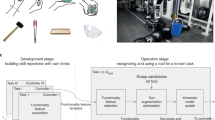Abstract
We propose a model for robots to use tools without predetermined parameters based on a human cognitive model. Almost all existing studies of robot using tool require predetermined motions and tool features, so the motion patterns are limited and the robots cannot use new tools. Other studies use a full search for new tools; however, this entails an enormous number of calculations. We built a model for tool use based on the phenomenon of tool-body assimilation using the following approach: We used a humanoid robot model to generate random motion, based on human body babbling. These rich motion experiences were then used to train a recurrent neural network for modeling a body image. Tool features were self-organized in the parametric bias modulating the body image according to the used tool. Finally, we designed the neural network for the robot to generate motion only from the target image.
Access this chapter
Tax calculation will be finalised at checkout
Purchases are for personal use only
Preview
Unable to display preview. Download preview PDF.
Similar content being viewed by others
References
Asada, M., Hosoda, K., Kuniyoshi, Y., Ishiguro, H., Inui, T., Yoshikawa, Y., Ogino, M., Yoshida, C.: Cognitive Developmental Robotics: A Survey. IEEE Trans. Auton. Mental Dev. 1(1), 12–34 (2009)
Maravita, A., Iriki, A.: Tools for the Body (Schema). Trends Cognit. Sci. 8(2), 79–86 (2004)
Stoytchev, A.: Behavior-grounded Representation of Tool Affordances. In: International Conference on Robotics and Automation–ICRA, pp. 3060–3065 (2005)
Nabeshima, C., Kuniyoshi, Y., Lungarella, M.: Towards a Model for Tool-Body Assimilation and Adaptive Tool-Use. In: IEEE International Conference on Development and Learning–ICDL (2007)
Nishide, S., Tani, J., Takahashi, T., Okuno, H.G., Ogata, T.: Tool-Body Assimilation of Humanoid Robot Using Neurodynamical System. IEEE Trans. Auton. Mental Dev. 4(2), 139–149 (2012)
Mochizuki, K., Nishide, S., Okuno, H.G., Ogata, T.: Developmental Human-Robot Imitation Learning of Drawing with a Neuro Dynamical System. In: 2013 IEEE International Conference on Systems, Man, and Cybernetics, pp. 2337–2341 (2013)
Arie, H., Endo, T., Arakaki, T., Sugano, S., Tani, J.: Creating Novel Goal-directed Actions at Criticality: A Neuro-robotic Experiment. New Math. Nat. Comput. 5, 307–334 (2009)
Kohonen, T.: Self-Organization and Associative Memory, 2nd edn. Springer, New York (1988)
Yamashita, Y., Tani, J.: Emergence of Functional Hierarchy in a Multiple Timescales Recurrent Neural Network Model: A Humanoid Robot Experiment. PLoS Comput. Biol. 4(11) (2008)
Rumelhart, D., Hinton, G., Williams, R.: Learning Internal Representation by Error Propagation. In: Rumelhart, D.E., McLelland, J.L. (eds.) Parallel Distributed Processing. MIT Press, Cambridge (1986)
Kokoro: Custom-made robot: ACTROID (2014), http://www.kokoro-dreams.co.jp/rt_tokutyu/actroid.html
Hikita, M., Fuke, S., Ogino, M., Asada, M.: Crossmodal Body Representation Based on Visual Attention by Saliency. In: Proc. IROS, pp. 2041–2046 (2008)
Author information
Authors and Affiliations
Editor information
Editors and Affiliations
Rights and permissions
Copyright information
© 2014 Springer International Publishing Switzerland
About this paper
Cite this paper
Takahashi, K., Ogata, T., Tjandra, H., Murata, S., Arie, H., Sugano, S. (2014). Tool-Body Assimilation Model Based on Body Babbling and a Neuro-Dynamical System for Motion Generation. In: Wermter, S., et al. Artificial Neural Networks and Machine Learning – ICANN 2014. ICANN 2014. Lecture Notes in Computer Science, vol 8681. Springer, Cham. https://doi.org/10.1007/978-3-319-11179-7_46
Download citation
DOI: https://doi.org/10.1007/978-3-319-11179-7_46
Publisher Name: Springer, Cham
Print ISBN: 978-3-319-11178-0
Online ISBN: 978-3-319-11179-7
eBook Packages: Computer ScienceComputer Science (R0)




